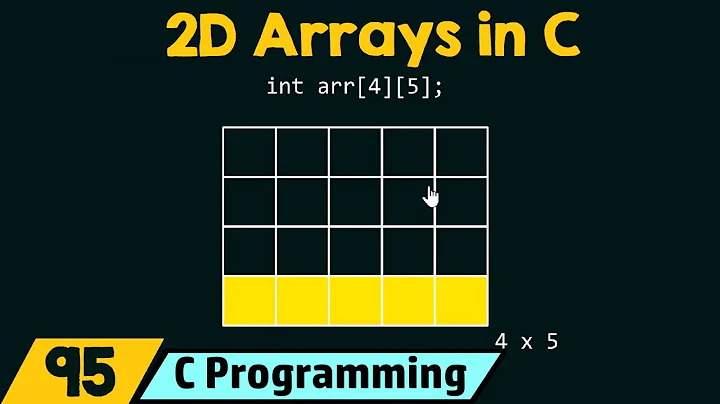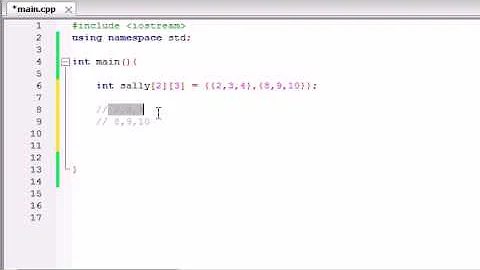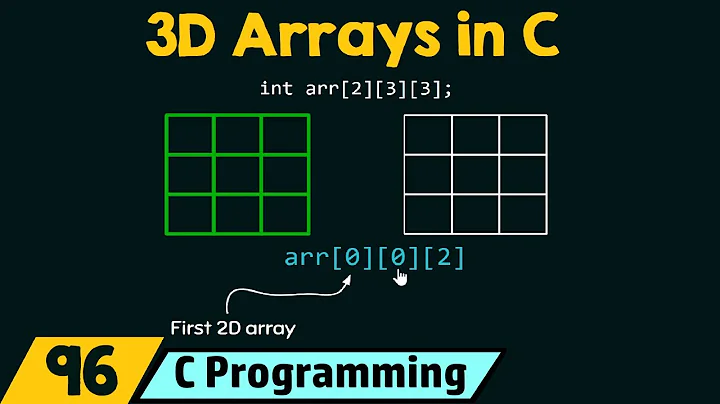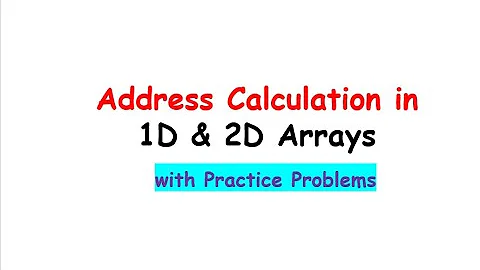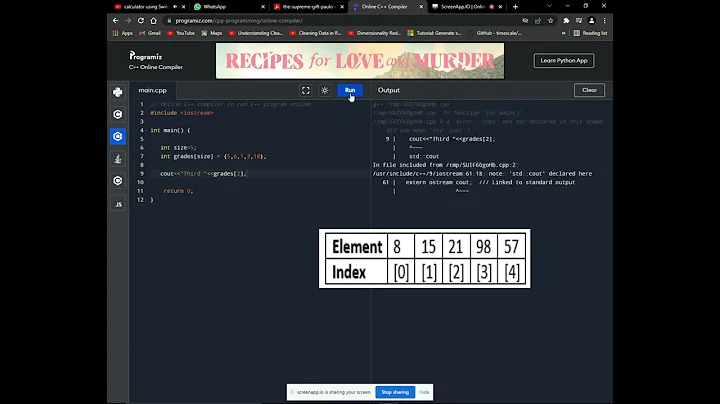How to map the indexes of a matrix to a 1-dimensional array (C++)?
Solution 1
The way most languages store multi-dimensional arrays is by doing a conversion like the following:
If matrix has size, n (rows) by m (columns), and we're using "row-major ordering" (where we count along the rows first) then:
matrix[ i ][ j ] = array[ i*m + j ].
Here i goes from 0 to (n-1) and j from 0 to (m-1).
So it's just like a number system of base 'm'. Note that the size of the last dimension (here the number of rows) doesn't matter.
For a conceptual understanding, think of a (3x5) matrix with 'i' as the row number, and 'j' as the column number. If you start numbering from i,j = (0,0) --> 0. For 'row-major' ordering (like this), the layout looks like:
|-------- 5 ---------|
Row ______________________ _ _
0 |0 1 2 3 4 | |
1 |5 6 7 8 9 | 3
2 |10 11 12 13 14| _|_
|______________________|
Column 0 1 2 3 4
As you move along the row (i.e. increase the column number), you just start counting up, so the Array indices are 0,1,2.... When you get to the second row, you already have 5 entries, so you start with indices 1*5 + 0,1,2.... On the third row, you have 2*5 entries already, thus the indices are 2*5 + 0,1,2....
For higher dimension, this idea generalizes, i.e. for a 3D matrix L by N by M:
matrix[ i ][ j ][ k ] = array[ i*(N*M) + j*M + k ]
and so on.
For a really good explanation, see: http://www.cplusplus.com/doc/tutorial/arrays/; or for some more technical aspects: http://en.wikipedia.org/wiki/Row-major_order
Solution 2
For row-major ordering, I believe the statement matrix[ i ][ j ] = array[ i*n + j ] is wrong.
The offset should be offset = (row * NUMCOLS) + column.
Your statement results to be row * NUMROWS + column, which is wrong.
The links you provided give a correct explanation.
Solution 3
Something like this?
//columns = amount of columns, x = column, y = row
var calculateIndex = function(columns, x, y){
return y * columns + x;
};
The example below converts an index back to x and y coordinates.
//i = index, x = amount of columns, y = amount of rows
var calculateCoordinates = function(index, columns, rows){
//for each row
for(var i=0; i<rows; i++){
//check if the index parameter is in the row
if(index < (columns * i) + columns && index >= columns * i){
//return x, y
return [index - columns * i, i];
}
}
return null;
};
Related videos on Youtube
Fernando Aires Castello
I'm a Java software developer from Florianópolis, SC (Brazil). I can speak Portuguese (natively), English, basic Romanian and basic modern Greek. I am able to program in C/C++, C#, Java, Javascript, Delphi, BASIC and Assembly (especially for Z80 and x86 architectures).
Updated on July 09, 2022Comments
-
 Fernando Aires Castello almost 2 years
Fernando Aires Castello almost 2 yearsI have an 8x8 matrix, like this:
char matrix[8][8];Also, I have an array of 64 elements, like this:
char array[64];Then I have drawn the matrix as a table, and filled the cells with numbers, each number being incremented from left to right, top to bottom.
If I have, say, indexes 3 (column) and 4 (row) into the matrix, I know that it corresponds to the element at position 35 in the array, as it can be seen in the table that I've drawn. I believe there is some sort of formula to translate the 2 indexes of the matrix into a single index of the array, but I can't figure out what it is.
Any ideas?
-
 WhozCraig over 11 years
WhozCraig over 11 yearsarr[i*cols+j]for equivalentmatrix[i][j]indexing, assuming you want row-major ordering, andcolsis your defined row width in columns (in your example's case,8). -
 Fernando Aires Castello over 11 yearsI've tried all kinds of simple calculations like multiplying row * column * 8, dividing, etc. but it doesn't work. I'm not very good at math.
Fernando Aires Castello over 11 yearsI've tried all kinds of simple calculations like multiplying row * column * 8, dividing, etc. but it doesn't work. I'm not very good at math.
-
-
 Fernando Aires Castello over 11 yearsI can't believe it was so simple... Very informative, thank you.
Fernando Aires Castello over 11 yearsI can't believe it was so simple... Very informative, thank you. -
Michael Dorst about 10 yearsAre you responding to zhermes' answer? If so you should probably just edit his/her post with your correction.
-
 Stewart_R over 9 yearsPerhaps you could you explain a little of how this relates to (and answers) the OP's original question?
Stewart_R over 9 yearsPerhaps you could you explain a little of how this relates to (and answers) the OP's original question? -
 Donny Verduijn over 9 yearsI should read a little better. It actually does the exact opposite as what the OP has asked for. This converts 35,8,8 to 3,4.
Donny Verduijn over 9 yearsI should read a little better. It actually does the exact opposite as what the OP has asked for. This converts 35,8,8 to 3,4. -
 Donny Verduijn over 9 yearsNow it illustrates both conversions :)
Donny Verduijn over 9 yearsNow it illustrates both conversions :) -
DilithiumMatrix over 8 yearsI'm pretty sure the current description is correct (as also described by @user1480848's answer below --- and corresponding edit on Mar 4, 2014). Please leave a comment if you don't think so - instead of editing the answer directly.
-
 Mohamad over 8 years@DilithiumMatrix shouldn't the formula be
Mohamad over 8 years@DilithiumMatrix shouldn't the formula bej + (i * n)and noti + (j * n)as you suggest? Consider coordinates2,3, which should return 13 using your matrix:3 + (2 * 5) = 13. If we used your formula instead, we would get2 + (3 * 5) = 17. Am I missing something? -
DilithiumMatrix over 8 years@Mohamad absolutely, thanks! That's also what user1480848 described below... I think I must have rolled back to the wrong edit. Should be fixed now. I hope.
-
Nitij over 8 yearsAlthough I had to swap row and columns for my use but this is exactly what I was looking for.
-
TMOTTM over 3 yearsAnd just to be sure because it's not always the same convetion, by 'n' you mean number of rows and 'm' the number of columns, right?
-
DilithiumMatrix over 3 years@TMOTTM, yes that's right. I tried to clarify the answer.
-
arapEST over 2 yearsHe is correct, you are probably setting up the (raw)array column major way in your head :)
